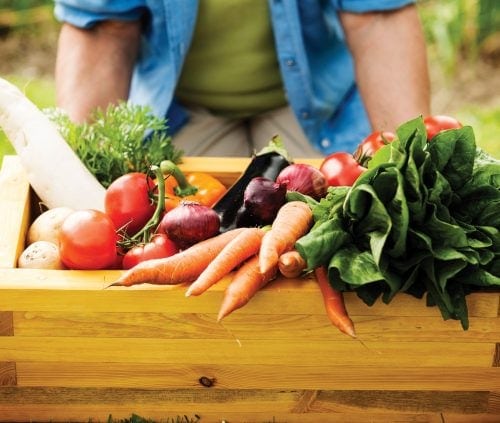
This month, David Haynes begins a new series: step-by-step guides on how to progress your edible garden each month.
Step 1 While my plot is east facing, it has been chosen as my vege garden site as it:
- gets sun (nearly) all day
- is sheltered from strong winds
- drains and does not get waterlogged
- is easy to access
- is near a water supply and compost pile
Step 2 While all grasses and weeds are pulled up and composted, this season’s marigolds are chopped straight into the soil as these act as a great chemical deterrent to tuber-eating worms such as nematodes.
Step 3 Next, the soil is turned over to a fork’s depth or down to no deeper than where the clay lies. If you’re lucky enough to have a soil which is not hard or compacted, you can get away without the dirty digging.
Step 4 To break up any clay in the soil sprinkle some gypsum (calcium sulphate) over the dug-over soil — this improves drainage without altering the pH of the soil. The pH is the measure of how acidic or alkaline a substance is. Soils should generally be around pH7 (neutral). It is worth investing in a soil-testing kit to keep an eye on the pH level as it is a major determinant in not only what but how well plants grow.
Step 5 Organic matter is now added to the soil. In my case, I spread on a generous layer of fresh horse manure and leave it on the top to decompose and act as a mulch. By next spring this will have been turned into plant food by the myriad micro-organisms in the soil.
Step 6 Finally, to ensure your hard work is not translated as a playground or toilet by chooks and/or cats, use netting to protect your new vege patch from such invasions and retire indoors for a well-earned drink.
Gardening Q&A
Q. Why does my broccoli always go to seed before it’s ready?
Andrea, Palmerston
A. There are several reasons why this may be happening:
Lack of nutrients: Broccoli needs plenty of food, particularly nitrogen, for green, leafy growth. Before planting, dig in well-rotted manure, compost or a nitrogen-rich fertiliser. Then give a monthly feed around the base of the plant.
Time of planting: Flowering in some plants is determined by the ratio of daylight to darkness hours. If you plant in high summer, fewer daylight hours in autumn can cause bolting.
Temperature: Brassicas grow good tight heads in cooler temperatures so plant in early spring or autumn. If brassicas are grown in a hot, dry location, they run to flower.
Lack of water stresses plants which results in early flowering. So keep soil moist by regular watering and apply a thick mulch over the soil (but not touching plant stems).
Root damage: Avoid touching the fine root hairs as damage may cause premature flowering.
Particular cultivar: Some cultivars (named varieties) of broccoli are more suited to one area versus another. Try several varieties to find the best one for your garden
Not enough cutting: Keep cutting because if you leave the king-head on the plant, the whole plant will bolt to flower.
www.healthyfood.com










